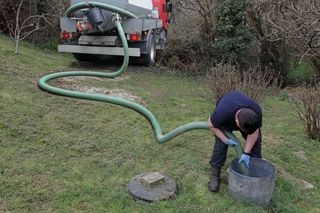What is a cesspit and are they still legal?
Cesspits are a simple drainage solution but there is a fair bit you need to know if you're thinking of installing one in your garden — including whether they are still legal

What is a cesspit?’ has become a more common question for homebuilders as property development moves into areas not connected to mains sewage.
What to do with sewage is perhaps one of the first problems self builders will come across when looking atoff mains drainagesystems.
One option is digging a hole and adding a cesspit, which is essentially a holding tank for the sewage, which is collected in the tank before periodically being pumped out by a lorry for disposal. With a cesspit, also known as a cesspool, there is no outlet to discharge or method of treating the sewage.
Of course, this might seem like a simple off mains drainage solution, but in some parts of the UK cesspits are now illegal and where they are still legal, they are only allowed to be added as a last resort. Here we explore what a cesspit is as well as looking at whether this might be an option for your project.
What is a cesspit?
A cesspit, or cesspool, is a waterproof and sealed tank that is buried underground to collect sewage. It is typically made from fibreglass and has a single access hole at the top. The advantage of a cesspit is that it provides a solution for waste disposal to homes that are not connected to the main drainage system.
A cesspit can also be used for temporary waste management such as on a building site or for seasonal use such as on campsites. Natalie Mitchell, property and construction expert atHomeHow.co.uk, says installing and removing a cesspit is fairly straightforward.
“It can be used in areas where a septic tank would not work well, such as in non-absorbent soils," she explains. "There are disadvantages to having a cesspit. It simply holds waste; it does not treat it or break it down in any way. A cesspit also has no outlet pipe and so will need to be emptied on a regular basis.”
What is the difference between a cesspit and septic tank?
The main difference between a cesspit and a septic tank is that a cesspit has no outlet pipe while a septic tank does.
A cesspit is simply a single-chamber holding tank for wastewater and does not treat or breakdown he sewage that it collects.
In contrast, a septic tank is a mini treatment plant for waste with two chambers. The first separates the solids from the liquid waste which then flows into the second chamber. This chamber further filters the waste. The treated water then exits the tank and seeps into a drainage field or soakaway.
You can find out more about 'what is a septic tank' as well as 'what is a soakaway' in our guides. You can also read up on 'how to build a soakaway' if this is something you are looking at adding to your home.
Is a cesspit illegal?
Cesspits are illegal in Scotland because of environmental concerns from leakage, but are allowed in England and Wales. However, there are strict rules that apply to them – particularly regarding their maintenance.
It is important that you have a cesspit emptied on a regular basis as it will continue to fill up with use. You must also not allow the cesspit to overflow or leak as this could contaminate the surrounding land and groundwater.
If the cesspit serving your property is not working properly or is in poor condition the Environment Agency or your local council can make you replace it.
As long as a cesspit is operated and maintained properly it can be environmentally friendly. The most important part of having a cesspit as a waste management system is that it is emptied by a licenced waste disposal contractor on a regular basis.
一个粪坑多久需要清空吗?
这取决于on the size of your cesspit and how much effluent your property discharges, but broadly a cesspit needs to be emptied before it gets full!
The average discharge per person is 150 litres per day, so if we take a 24,000 litre capacity, four people will fill this in 40 days, so the tank will need emptying every 40 days.
Emptying a cesspit will cost between £100 and £300 each time. As ever, get advice from a professional who can advise you on what capacity your property requires.
Can I sell a house with a cesspit?
When selling a property with off mains discharge you will need to disclose this fact to potential buyers in writing.
Natalie adds: “This should include a description of the particular waste management system, where it is located and how to maintain it, including any records you have.”
Get the Homebuilding & Renovating Newsletter
Bring your dream home to life with expert advice, how-to guides and design inspiration, direct to your inbox.
Sam is based in Coventry and has been a news reporter for nearly 20 years. His work has featured in the Mirror, The Sun, MailOnline, the Independent, and news outlets throughout the world. As a copywriter, he has written for clients as diverse as Saint-Gobain, Michelin, Halfords Autocentre, Great British Heating, and Irwin Industrial Tools. During the pandemic, he converted a van into a mini-camper and is currently planning to convert his shed into an office and Star Wars shrine.
Most Popular
Bring your dream home to life with expert advice, how-to guides and design inspiration, direct to your inbox.
Thank you for signing up to Homebuilding. You will receive a verification email shortly.
There was a problem. Please refresh the page and try again.

